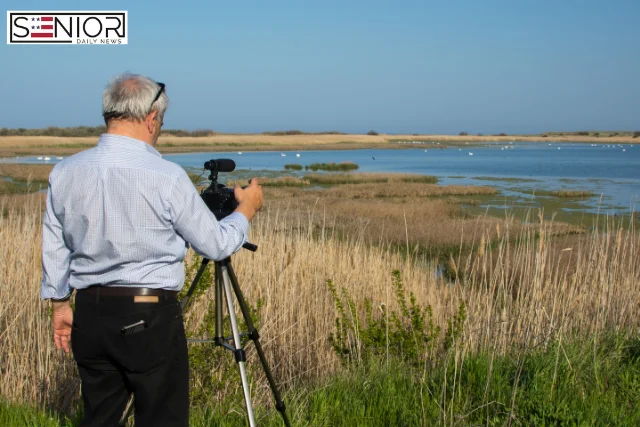Why Birdwatching Is the Perfect Hobby for Your Golden Years

As we enter our golden years, life begins to slow down in the best way possible. There’s more time to savor each moment, to explore new interests, and to reconnect with the beauty of the world around us. For many seniors, finding a hobby that blends relaxation, gentle physical activity, and mental stimulation can feel like striking gold. One pastime that checks all those boxes—and then some—is birdwatching. Whether you’re sitting in your backyard with a cup of coffee or strolling through a park with binoculars in hand, birdwatching offers joy, discovery, and a sense of connection to nature that can enrich your retirement years.
A Hobby That Meets You Where You Are
One of the most appealing aspects of birdwatching is its flexibility. You can tailor it to your energy level, mobility, and schedule. Some days you might feel like a short walk to a local trail; other days, you may prefer to simply watch from your porch. Either way, you can enjoy the thrill of spotting familiar species and perhaps even catching sight of a rare visitor. Unlike many hobbies that require a big time commitment or costly equipment, birdwatching can be as simple or as involved as you want it to be.
Affordable and Accessible
Many retirees appreciate hobbies that don’t drain the budget. Birdwatching is incredibly affordable to start. All you really need are your eyes and ears. While binoculars and field guides can enhance the experience, they’re not essential for beginners. Public parks, nature reserves, and even urban green spaces offer free or low-cost opportunities for observing birds. For those with limited mobility, a bird feeder outside your window can bring the action right to you.
A Gentle Boost to Physical Health
Although birdwatching is not a high-intensity workout, it naturally encourages gentle movement. Strolling through a park, standing to get a better view, or walking along a nature trail can all help keep your muscles and joints active. These low-impact activities can improve balance, flexibility, and cardiovascular health—benefits that are especially important as we age. Even light exercise like this can help maintain independence and overall wellness.
Sharpening the Mind
Birdwatching isn’t just about seeing birds—it’s about noticing details. Identifying different species means paying attention to color patterns, behaviors, calls, and flight styles. This kind of observation stimulates the brain, improves focus, and strengthens memory. Many birdwatchers keep journals or logs of their sightings, which adds a creative and reflective element to the hobby. Learning new bird songs or studying migration patterns can also help keep the mind agile well into later years.
A Natural Stress Reliever
Time in nature has a well-documented effect on lowering stress levels and improving mood. The quiet patience of birdwatching encourages mindfulness, allowing you to focus on the present moment. Listening to birdsong, breathing in fresh air, and watching wildlife move freely can be deeply calming. For those managing the emotional challenges of aging—such as loneliness or anxiety—birdwatching can offer a peaceful daily ritual.
Building a Social Circle
Birdwatching can be a solo hobby, but it’s also a wonderful way to meet like-minded people. Many communities have birdwatching clubs, nature groups, or guided walks where enthusiasts gather to share sightings and swap tips. Socializing in this way can provide companionship, boost self-confidence, and even foster new friendships. With events often scheduled in the morning or early afternoon, they fit well into a senior lifestyle.
Discovering Local and Global Beauty
Birdwatching connects you to your surroundings in a unique way. You begin to notice the changing seasons, migration cycles, and even the impact of local weather patterns on wildlife. It also opens the door to travel—whether that’s a day trip to a nearby wildlife refuge or a planned vacation to a renowned birding destination. Many birdwatchers find themselves visiting national parks or coastal areas just to experience different species in their natural habitats.
Supporting Conservation Efforts
Birdwatching naturally fosters an appreciation for wildlife and the environment. Many enthusiasts become involved in conservation efforts, such as participating in bird counts, volunteering at nature centers, or advocating for habitat protection. These activities provide a sense of purpose and allow retirees to contribute to a cause that benefits both animals and the community.
Getting Started with Birdwatching
If you’re new to birdwatching, the best way to begin is simply to look and listen. Choose a spot with trees, shrubs, or water, and spend a few quiet minutes observing. You may be surprised at how much you notice when you take the time to slow down. Consider keeping a small notebook to jot down descriptions of birds you see. Later, you can use a field guide or smartphone app to identify them. As your interest grows, you might invest in a pair of binoculars for clearer views, or join a local birding group to learn from others.
Birdwatching from Home
For those who prefer to enjoy nature without leaving home, setting up a bird-friendly space in your yard can be incredibly rewarding. A combination of feeders, birdbaths, and native plants can attract a variety of species year-round. Watching from the comfort of your kitchen window can be just as engaging as a walk in the park—especially when you begin to recognize returning visitors season after season.
Birdwatching and Technology
While birdwatching is rooted in nature, technology can enhance the experience. Apps like Merlin Bird ID, eBird, and Audubon Bird Guide can help you identify species, log sightings, and even connect with other birdwatchers around the world. Some apps also offer recordings of bird calls to help you learn to identify species by sound.
Staying Safe While Birdwatching
If you choose to explore parks and trails, be sure to take simple safety precautions. Wear comfortable shoes, bring water, and dress for the weather. Let someone know where you’re going if you’re heading out alone. Carry a small first-aid kit in case of minor scrapes, and be aware of your surroundings to avoid tripping or straying off marked paths.
The Joy Is in the Journey
Perhaps the most wonderful thing about birdwatching is that there’s no end goal—no finish line, no competition. The reward lies in the process: the anticipation of spotting movement in the trees, the thrill of identifying a new species, the quiet moments of stillness in a busy world. For seniors, birdwatching can be a fulfilling, health-boosting, and soul-nourishing activity that fits seamlessly into everyday life.
FAQs About Birdwatching for Seniors
1. Do I need expensive equipment to start birdwatching?
No. You can begin with just your eyes and ears. While binoculars can improve your view, they’re not essential for beginners.
2. Is birdwatching safe for older adults?
Yes, especially when you choose safe, accessible locations like public parks, nature reserves, or your own backyard. If going on trails, take standard safety precautions.
3. Can birdwatching help with mental health?
Absolutely. Time in nature, gentle activity, and mindful observation can reduce stress and boost mood.
4. How can I attract birds to my yard?
Use a mix of bird feeders, birdbaths, and native plants to create a welcoming environment for different species.
5. Can I enjoy birdwatching if I have limited mobility?
Yes. Birdwatching from home with a feeder or visiting accessible parks can provide just as much enjoyment.
Image Source: Canva






